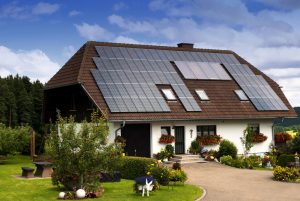With global warming continuing to hurt the planet, it’s about time that the average homeowner starts thinking about changing the way they live. One of the first things we, as private citizens, can do to help the planet is to start turning our homes into energy-efficient dwellings. An energy-efficient home has a lot of benefits to the average consumer: it saves you money by reducing your energy expenses, provides you with better levels of comfort without sacrificing aesthetic design, and not to mention increases the resale value of your home in general.
Energy-efficient homes also have the added advantage of being useful tools against global warming. If more homes were energy-efficient, our reliance on oil, gas, and coal lessens, which in turn significantly reduces greenhouse gases and ultimately slows down global warming.
Luckily, scientists and researchers from around the world are developing new construction materials and building techniques that help more people create energy-efficient homes. These new technologies have made energy-efficiency a cheaper, viable, and better alternative to traditional building methods.
Energy-efficient homes have a few things in common: a tightly sealed “thermal envelope” that helps regulate interior temperatures, efficient HVAC systems, doors and windows that passively control heating and cooling, as well as appliances and home electronics that augment all these processes.
The dream of every environmentalist is to create what is called a “net zero energy use” home, which is a dwelling that uses purely renewable energy and is completely independent from carbon emitting sources of energy like coal or gas without sacrificing style, comfort, and livability.
To get you started, we’ve compiled a few tips to creating your own energy-efficient home.
Back to the Drawing Board
 The first step in creating an energy-efficient home is to rethink the way we design houses in the first place. Many scientists advocate using the “Whole Building System”.
The first step in creating an energy-efficient home is to rethink the way we design houses in the first place. Many scientists advocate using the “Whole Building System”.
The Whole Building System is an engineering and architectural approach to house construction that sees the home as a single energy system. Within this system, every individual aspect of the house is built in such a way that it affects the overall flow of energy in the entire building. This means that every part of the house, from living rooms and flooring to plumbing and electrical, are all designed to use as little materials as possible and create as minimal waste as possible. By doing so, homeowners are able to lower their overall maintenance costs, not to mention improve the durability of their house while maintaining maximum levels of comfort.
This type of approach also has the added advantage of creating a safe and healthy environment for the homeowners, as there are fewer chances of toxic materials present in the building.
Approach your home with a Whole Building System by following these steps:
– Start in the right direction: One of the key elements of a whole building approach is to create opportunities for passive solar design. This means aligning your home in such a way that it takes advantage of the energy from the sun. For homes in the northern hemisphere, it’s best to orient your house from North to South, as this minimizes the effects of the sun during summer while maximizing its effects during winter.
 – Rooms in the right place: With passive solar design in mind, orient your rooms to take full advantage of the sun. Rooms facing the south receive the most amount of sun during the day, so it’s best to turn it into communal spaces like a living room or a dining room. Rooms facing the east get plenty of sun in the mornings and are cool during the afternoons, which makes it perfect for kitchens or even bedrooms. Rooms facing the North get the least amount of sun, so it’s best to turn these into utility areas like laundry rooms or garages.
– Rooms in the right place: With passive solar design in mind, orient your rooms to take full advantage of the sun. Rooms facing the south receive the most amount of sun during the day, so it’s best to turn it into communal spaces like a living room or a dining room. Rooms facing the east get plenty of sun in the mornings and are cool during the afternoons, which makes it perfect for kitchens or even bedrooms. Rooms facing the North get the least amount of sun, so it’s best to turn these into utility areas like laundry rooms or garages.
– Use the right materials: Energy-efficient homes require the use of specialized materials that maximize heat during winter and minimize it during summer. Look into using high thermal mass materials when building your home. These materials help regulate interior temperatures by slowing down heat transfer from the outside. Concrete, brick, and stone are good examples of high thermal mass materials, while wood and steel are not.
– Air Flow is key: design your home in such a way that air can flow freely from one room to the next. This is essential in lowering the need for mechanical ventilation, which in turn lowers your energy usage. Wall insulation should be uncompressed but sealed, which helps avoid air leakage and condensation. Preventing moisture build up inside your home and walls will deter rot and mildew growth. Install an HVAC system with the highest levels of efficiency, as this improves the airflow inside your home. Proper ventilation will also help you regulate the temperature without using too much energy.
 – A Green Roof is a Cool Roof: with a majority of the sun’s heat being absorbed through the roof, it’s essential for an energy-efficient home to maintain a roof that protects against solar heat gain. Using high thermal mass materials like asphalt singles are very good at absorbing the heat from the sun, but will eventually transfer that heat into the interior. Instead, consider a green roof. Green roofs are roofs that are covered in plants or vegetation, and can even be converted into a garden or mini urban-farm. This simple solution can effectively lower your house’s energy consumption while providing you with a cool, green space to enjoy, not to mention provide you with an opportunity to grow your own vegetables or fruits.
– A Green Roof is a Cool Roof: with a majority of the sun’s heat being absorbed through the roof, it’s essential for an energy-efficient home to maintain a roof that protects against solar heat gain. Using high thermal mass materials like asphalt singles are very good at absorbing the heat from the sun, but will eventually transfer that heat into the interior. Instead, consider a green roof. Green roofs are roofs that are covered in plants or vegetation, and can even be converted into a garden or mini urban-farm. This simple solution can effectively lower your house’s energy consumption while providing you with a cool, green space to enjoy, not to mention provide you with an opportunity to grow your own vegetables or fruits.
– Glaze your windows: any point of entry that can let in light, such as windows, doors, skylights, among others, are all sources of warmth and ventilation and must thus be regulated. Windows facing the sun should be glazed to minimize heat, while skylights and doors should be built to accommodate light and warmth from the outside. Window shades and curtains also help regulate the interior temperatures of a home.
– Energy Efficient Electronics: appliances and electronics are by and large the largest consumers of energy in any home. Ensure that your energy-efficient home is stocked up with appliances that carry the ENERGY STAR seal, as this indicates it as having high levels of energy-efficiency. Other energy-efficient electronics include LED’s, or light emitting diodes. LED bulbs are proven to be 90% more energy efficient than traditional incandescent bulbs. They can be expensive, with some models going up to 40$, however they last 50 times longer than regular bulbs and can save you large amounts of money in the long run.
 – Stick to Renewables: an energy-efficient home should be tapped into a renewable energy source. Various technological developments have made solar, wind, and even hydropower (albeit in a smaller scale), commercially available and easy to install. If you’re in a sunny area, consider installing lightweight solar panels in areas that receive the most amount of sun, like your roof or the yard. Wind turbines are also available for private use. If your house is near a river, micro turbines can be installed to provide you with a constant source of energy. Not only does this help the planet, it also gives you tax breaks.
– Stick to Renewables: an energy-efficient home should be tapped into a renewable energy source. Various technological developments have made solar, wind, and even hydropower (albeit in a smaller scale), commercially available and easy to install. If you’re in a sunny area, consider installing lightweight solar panels in areas that receive the most amount of sun, like your roof or the yard. Wind turbines are also available for private use. If your house is near a river, micro turbines can be installed to provide you with a constant source of energy. Not only does this help the planet, it also gives you tax breaks.
Constructing an energy-efficient home is all about finding the right tools and the right building techniques. So put your boots on and help save the planet, one home at a time!






